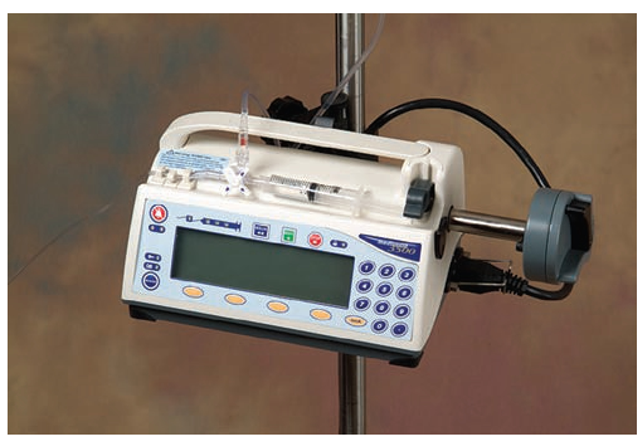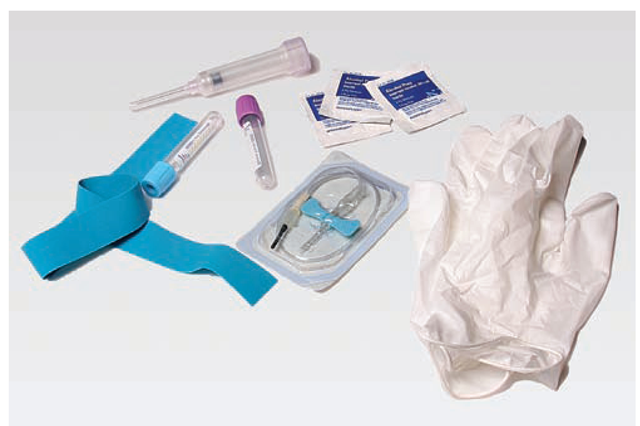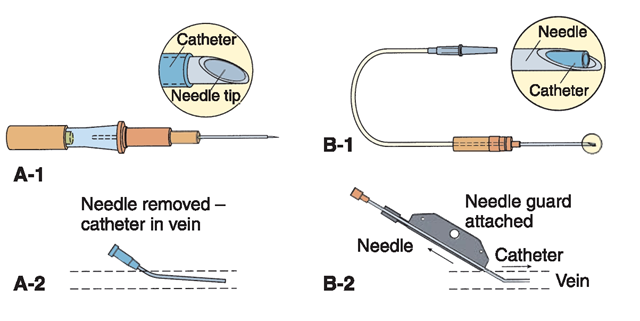Administration of Medications via Piggy Back
Frequently, medications are given at scheduled intervals (e.g., twice daily) using a separate premixed IV bag and additional IV tubing connected to an existing IV infusion (Fig. 64-16). This method of administration is referred to as “IV piggyback” (IVPB) or a superimposed infusion. It may also be called a small-volume parenteral delivery system, a partial fill, or a minibottle. The client receiving a piggyback administration of medication also has a “primary” IV, which is usually one of the more commonly ordered IV solutions (e.g., normal saline—0.9% NaCl). A small bottle delivery system may also be delivered into a saline lock.
FIGURE 64-16 · A basic intravenous (IV) setup includes tubing to deliver basic IV fluids via the client’s venous access. Also shown are the access port on the tubing, used for injection of small amounts of medication by syringe (below) and the access port used for piggyback administration of larger amounts of medication (above). These needleless ports prevent needlestick injuries to staff. (Blood and total parenteral nutrition [TPN] are administered through a different type of IV tubing.
Following the physician’s order and using a second infusion bottle or bag, the pharmacist adds medication to a predetermined volume (usually, 50 or 100 mL) of a compatible IV solution. This smaller infusion, which contains medication, commonly an antibiotic, is referred to as the secondary infusion, superimposed infusion, or IVPB. The IVPB is connected to the primary infusion by way of secondary tubing and a needle or needleless setup. The IVPB is administered over a period of up to 1 hour (e.g., for mycins), or as ordered by the physician.
The controller or pump can be programmed to deliver the volume contained in the secondary bag. When the total contents of the secondary bag have been administered to the client, the controller or pump automatically switches back to the primary infusion bag. The secondary bag must be hung higher than the primary bag to allow a greater force of gravity to act on the secondary solution. In Practice: Nursing Procedure 64-10 describes the process of piggyback administration of medications.
Nursing Alert If a pump or controller is not used, the drip rate must be calculated (see Box 64-2). Request assistance if there are any questions.
Administration of Medications via Volume-Controlled Infusion
Another method of medication administration is with the volume controller. The solution to be used to dilute the medication is supplied in a small bag. This bag is hung on an IV pole and a volume-control device, such as the Buretrol, is hung below it. After priming the tubing, the ordered amount of diluent is run into the volume-control chamber (usually from 25-250 mL). Then, the prescribed medication is injected into the intake port of the chamber. This infusion is often given piggyback (see In Practice: Nursing Procedure 64-10). The procedures for running this infusion are the same as for any other infusion. The rate of administration must be carefully controlled. In this way, a very exact amount of IV fluid and medication is administered. In Practice: Nursing Procedure 64-11 describes and illustrates the process of using the volume-controlled administration setup.
Administration of Medications by IV Bolus or Push
Medications may be given by IV “push,” also called a bolus. This injection is given in a short period of time and is not intermittent. The IV push only requires a small amount of fluid. Thus, it is often recommended for a client who is at risk for fluid overload. Many facilities have firm policies regarding which medications may be given by IV push,because the push introduces a concentrated dose of medication directly into the circulatory system. This procedure is presented in In Practice: Nursing Procedure 64-12, although it is highly recommended that the nurse receive specific inservice education before performing the procedure. In some cases a “smart pump” is used. This type of pump is able to identify dosing limits and other factors to aid in safe administration (Fig. 64-17).
FIGURE 64-17 · A computerized syringe-infusion pump or mini-infusion pump ("smart pump”) holds a syringe containing medication in a small amount of solution; it is connected to a primary infusion. The pump applies mechanical pressure to the plunger of the syringe, to deliver the medication; it can be programmed to repeat the same infusion at regular intervals (e.g., every 4 hours) around the clock. This pump is able to identify dosing limits and has other safeguards to protect the client.
Key Concept Do not refer to a medication as an IV push if it is to be given over a period of time. In this case, identify the procedure as "an IV to be given over 5 minutes or over 10 minutes,” for example.
Nursing Alert The IV push is a dangerous method of administering IV medications. In many areas, an LPN/LVN is not allowed to perform this procedure.
Special nursing considerations include:
• It is vital to calculate the dosage correctly
• This method of administration does not allow any time to correct an error
• Often, the facility requires two nurses to double-check all IV push medications.
• The IV push may irritate the lining of the blood vessel.
• It is vital to confirm that the IV catheter is in the vein and the fluid is flowing freely
• If it appears that the IV is infiltrated, the push should not be given.
• If IV push medication is injected into surrounding tissue, rather than the vein, serious problems can occur including an abscess or tissue sloughing.
• If an IV push is given too fast, it can cause very serious complications, including death.
If in doubt, do not give a medication by IV push! Ask for assistance if you have any questions.
FIGURE 64-18 · The nurse will often be expected to gather materials and equipment for venipuncture (phlebotomy). Some of the items needed to obtain a blood specimen are shown here (clockwise, from bottom left): tourniquet, Vacutainer (vacuum) blood tubes, safety syringe with needle, alcohol sponges, and gloves. Shown also is a butterfly needle pack with a needleless Vacutainer adaptor; used to puncture a Vacutainer blood tube. Also needed are 2 X 2 gauze squares and tape or a Band-Aid, identification stickers, and a red biohazard bag. A Vacutainer sleeve and/or needle system may also be used. (If the butterfly needle is used, the syringe and needle are not required.) Additional items are needed to initiate an IV infusion.
VENIPUNCTURE
Venipuncture or phlebotomy is the process of puncturing a vein for the purpose of obtaining a blood specimen (“drawing blood”) or establishing an intravenous access site (Fig. 64-18). Blood tests are very commonly used diagnostic tools. The blood specimen can yield valuable information regarding the client’s nutritional, metabolic, hematologic, immune, and biochemical status. Blood tests can reveal many disorders, as well as response to treatment. Blood levels of various drugs, illegal and prescribed, can be determined. A blood pregnancy test confirms or denies pregnancy. DNA testing is used for many purposes. A blood culture identifies microorganisms that might be causing disease. When combined with a sensitivity test, it can identify specific antibiotics or other drugs to combat offending pathogens.
If an IV site is to be established, several devices are available to be used (Fig. 64-19).
The Vacutainer system is often used for venipuncture. It consists of a disposable plastic sleeve into which a double-ended needle setup is inserted. This device has a needleless connector on one end and a venipuncture needle on the other end. The needleless end is screwed into the plastic sleeve, with the needle outward and the needleless access device inside the sleeve. The needle end for blood drawing often contains an articulated shield, which is pushed over the needle after the venipuncture (see Fig. 64-4A). If this is not present, a Point-Loc device must be used (see Fig. 64-4B). One disadvantage of the Vacutainer needle with the articulated shield is that this system contains a large needle, which might not be appropriate for some venipunctures. If a smaller needle is desired, a butterfly needle is used. Butterfly needles are available with adaptors to be used with Vacutainer sleeves (see Fig. 64-18) or for initiating IVs. After the vein is accessed by any method, the needleless connector is pushed into a Vacutainer (vacuum) tube, which draws the blood into the tube.
A blood specimen can also be obtained by a skin puncture (capillary puncture), as in blood sugar testing for persons with diabetes. In addition, an arterial puncture can be performed to obtain values, such as blood gas analysis. In some cases, a blood sample can be taken from an existing IV infusion.
The procedure for venipuncture is contained in In Practice: Nursing Procedure 64-13. Arterial puncture is beyond the scope of this topic. In the case of blood cultures, the facility will identify specific procedures to follow.
Key Concept It is important to remember that venipuncture is not without some discomfort. In addition, the sight of a needle is frightening to many people, particularly children. It is up to the nurse to reassure the client and make him or her as comfortable as possible.
Nursing Alert The sequence of blood collection is important. Blood cultures should be collected first, followed by plain red or gold tubes. Other tube colors follow in the sequence dictated by the healthcare facility.
In addition, some tubes must be inverted several times immediately after collection. Some must be sent to the laboratory on ice. Follow the facility’s protocol.
FIGURE 64-19 · Venous access devices (VAD). In addition to the butterfly needle, two types of intracatheters are commonly used, allowing fluid to flow through a flexible catheter into the vein. (A-1) An over-the-needle catheter is inserted into the vein and, (A-2) the needle is removed, leaving the catheter in the vein.(B-1) A through-the-needle catheter is passed through the needle after the needle is inserted into the vein. (B-2) The needle is pulled out, leaving the catheter in the vein. Both of these devices today have a locking guard mechanism that locks the needle guard in place, to prevent needle sticks when the catheter is in place and when it is removed.
KEY POINTS
• Parenteral administration of medications carries more risk than does oral administration.
• The nurse must be knowledgeable in drawing up and preparing medications for injection.
• It is important to take precautions to prevent needlestick injuries.
• Proper technique and site preparation for intradermal, subcutaneous, intramuscular, and intravenous injections are essential to prevent errors, infections, and/or injury to the client.
• Monitoring of IV infusion solutions, rates, and sites is very important. Prevention of infiltration, phlebitis, and/or infection is necessary.
• Administration of medications via the intravenous route requires accuracy, because errors can be immediately life threatening.
• The nurse needs great skill to administer IV medications by any method. Special inservice education is usually required before the new graduate is permitted to administer IV medications, perform venipuncture, and/or start IVs.
• It is important to know what materials to assemble in order to assist with, or to perform, venipuncture, including starting an IV infusion. The equipment must all be ready before beginning.
• It is important to seek assistance if there are any questions about IV administration.
• Each pump is programmed differently. Follow the manufacturer’s instructions, which are usually kept attached to the pump.
![A basic intravenous (IV) setup includes tubing to deliver basic IV fluids via the client's venous access. Also shown are the access port on the tubing, used for injection of small amounts of medication by syringe (below) and the access port used for piggyback administration of larger amounts of medication (above). These needleless ports prevent needlestick injuries to staff. (Blood and total parenteral nutrition [TPN] are administered through a different type of IV tubing. A basic intravenous (IV) setup includes tubing to deliver basic IV fluids via the client's venous access. Also shown are the access port on the tubing, used for injection of small amounts of medication by syringe (below) and the access port used for piggyback administration of larger amounts of medication (above). These needleless ports prevent needlestick injuries to staff. (Blood and total parenteral nutrition [TPN] are administered through a different type of IV tubing.](http://what-when-how.com/wp-content/uploads/2012/08/tmp7ff0118_thumb2222_thumb.png)



